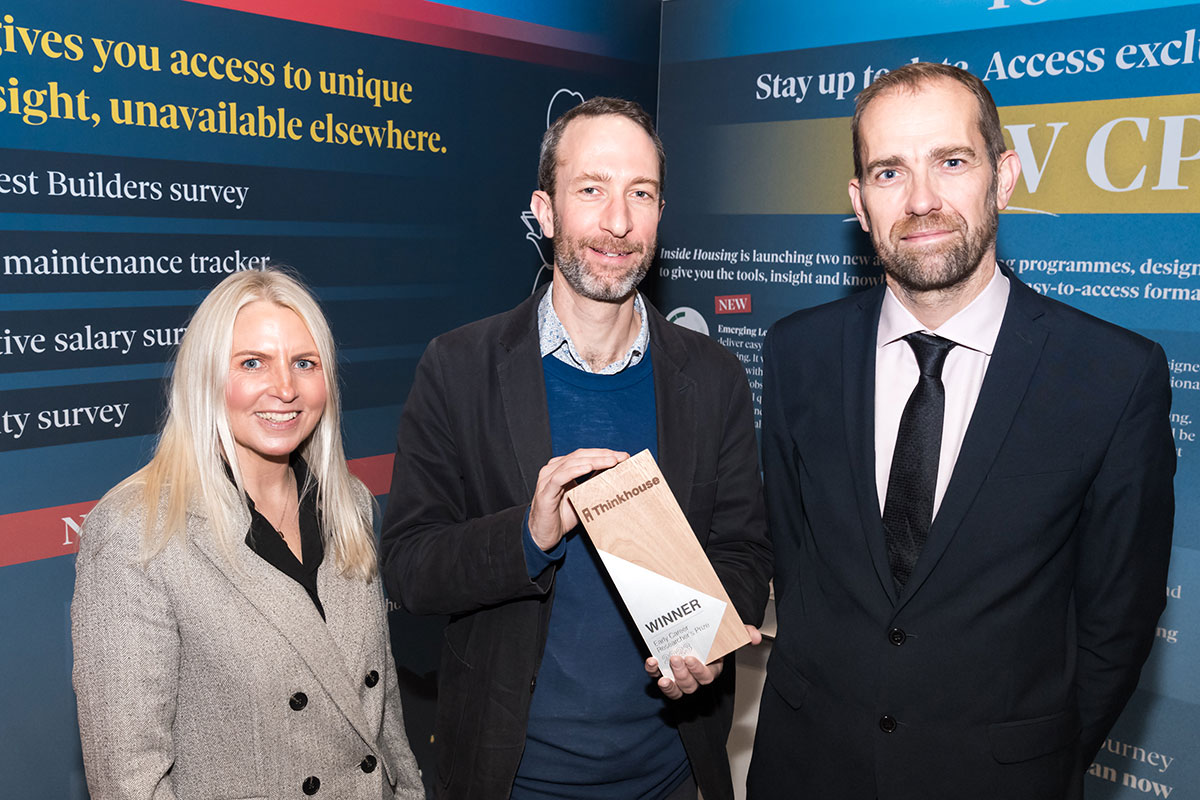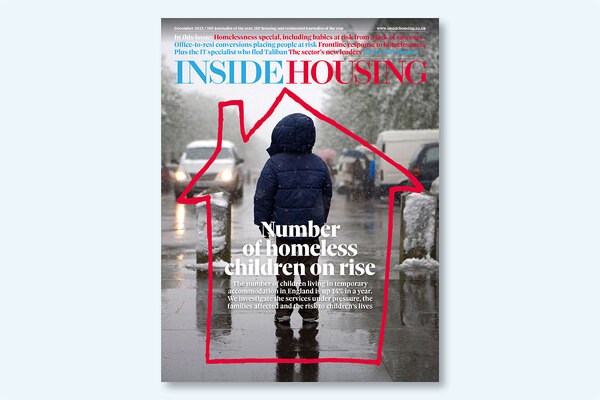You are viewing 1 of your 1 free articles
The Thinkhouse review of the year’s housing research
Richard Hyde, chair of a new panel set up to critique housing-related research, gives his take on the year’s publications
Thinkhouse was set up last spring.
It provides a single location and summary of the best and most innovative research pieces, policy publications and case studies that propose ways to increase the amount and quality of the UK’s housing stock and the related economic, social and community benefits of doing this.
The aim is to help policymakers and practitioners have easy access to and keep up to date with the latest thinking.
The editorial panel, which is independent of all interest and political groups, selects and writes reviews of the best reports.
Below, I discuss the main themes from the key reports of 2017 and fellow members of the editorial panel highlight some of the surprising gaps in research produced this year.
We are not building enough houses of all tenures
The seminal work produced in 2004 by Kate Barker – the Barker Review of Housing Supply – defined the number of houses that needed to be built each year to support macroeconomic stability, labour market flexibility and provide more affordable housing at between 195,000 and 245,000.
This was referenced in many of this year’s publications, including the government’s own housing needs analysis in February’s Housing White Paper titled Fixing our broken housing market, which set a figure of 225,000 to 275,000 homes per year.
Since the 1970s there have been on average 160,000 new homes built each year.
In 2016/17 we built 183,570. This increases to 217,000 if change of use is included.
There was no shortage of solutions offered to resolve the lack of supply in total and across particular forms of tenure, including social housing – some of which may have helped influence the government’s renewed interest.
Housing our ageing population and the implications of not doing this was the focus of a number of papers.
Solutions offered to help resolve the housing shortage
Land: Land availability and the scope it has to impact on the ability to deliver housing was looked at in a number of papers.
The Institute for Public Policy Research (IPPR) and Michael Lyons edited a collection of think pieces that offered a variety of imaginative and thoughtful analyses.
This report covers a wide variety of areas and our editorial panel praised the strength of its analysis.
The section on land reform challenges the boundaries and quality of the current green belt provision where no real changes have occurred since 1955.
It questions why, if we can reform the NHS, the green belt is sacrosanct.
It has an insightful chapter on the German success at land assembly – something that Nick Boles MP picked up in his housing think piece published in the autumn.
Civitas develops this further in its Building Homes Faster? report and its very recent update titled The Land Question, which proposes amending the Land Compensation Act to remove “hope value” which they believe is increasing the cost and slowing the pace of construction.
Planning: Planning and its liberalisation was a common theme, with many proposing this as an important way to get more houses built, but we were reminded by Mr Lyons and the IPPR of the evidence from the Spanish and Irish property crunches that planning freedoms were contributory causes.
Local authorities: The potential of councils to increase the supply of housing was commented on by many.
Towards the end of 2017 the Association of Retained Council Housing and the National Federation of ALMOs published an analysis that concluded that lifting Housing Revenue Account (HRA) borrowing caps would allow local authorities to deliver at least 15,000 new homes.
This would be achieved by allowing councils to manage the HRA in line with the existing Prudential Code for public borrowing.
“The potential of councils to increase the supply of housing was commented on by many.”
Localis also looked in detail at the benefits to housebuilding of lifting the HRA cap.
The rise of local housing companies was reviewed in October by the Smith Institute.
It suggested that local housing companies offer councils a “triple dividend” in the form of much-needed extra housing, a greater stewardship role in place-shaping and a financial return to the council. There are now probably as many as 150 local housing companies in England, most formed in the past few years.
On the current trend, this could increase to 200 by the year 2020.
Funding: One of the more imaginative ideas was on funding and Respublica’s proposal for a National Housing Fund.
This would boost housing supply by using the government’s ability to borrow money at historically low rates.
It calls for £100bn of investment over 10 years which would build up to 40,000 more rental homes per annum.
“The Thinkhouse editorial panel questioned whether all the new houses would really be additional.”
The money is invested in homes for rent, managed by housing associations (which also own a share of the fund).
Rents are used to repay interest costs and management costs.
It is noteworthy that this report seems to be underpinning some of the current government ‘chatter’ on the way to radically boost supply.
The Thinkhouse editorial panel questioned whether all the new houses would really be additional.
Structural constraints: Constraints caused by the decline of small building companies and over-centralisation were well covered.
Two reports on devolution stood out.
The Smith Institute suggests ways that the new metro mayors can use their powers to the best advantage and what other powers could be devolved.
At times this does become a bit of list of government asks but the analysis picks up on some of the more creative and innovative proposals.
The JRF has identified that at present only a small number of small city and town local authorities are addressing inclusive growth through direct intervention.
The JRF concludes this is a key missed opportunity, and that the small number of proactive interventions being pursued at the moment could be easily scaled up and pursed at the metropolitan level.
Modern methods of construction: The need for the housebuilding sector to modernise its methods of construction was picked up in the government’s Housing White Paper, which followed the comprehensive analysis produced last October by Mark Farmer.
This 80-page review had a ‘by the sector, for the sector’ feel to it.
“There are sections of the Farmer Review that focus on the minutiae of what trade bodies need to be doing.”
As a result there are sections that focus on the minutiae of what trade bodies need to be doing to respond to a stark picture of low productivity, poor skills and old fashioned procurement.
If the built environment sector wants to see a change in behaviour, a detailed prescription is probably needed – and here it is!
Rent controls: Regulation of rents has reappeared on the political horizon and Thinkhouse selected three reports that shed light on the subject.
These are Alex Hilton’s How to repair the housing market quickly for the Communication Workers’ Union, IPPR’s examination of the German rental market and JRF’s review of the Irish regulation system for their rental market.
Housing our ageing population: 2017 saw a steady flow of reports that assessed the consequences and costs of not housing our ageing population in appropriate housing.
Many analysed the impact on care support services.
In September, KPMG in its Reimagine Housing report took a look at sharing the value of an older person’s existing property between the costs of buying a new smaller flat in a modern care complex, their relatives, future living costs and future care costs.
It also considered multi-generational living, ie students offered cheap accommodation in exchange for acting as a ‘buddy’.
“2017 saw a steady flow of reports that assessed the consequences and costs of not housing our ageing population in appropriate housing.”
The Local Government Association, along with the Housing Learning and Improvement Network, produced Housing our Ageing Population, which offered some useful statistics and best practice case studies.
The number of people aged over 65 is forecast to rise over the next decade, from the current 11.7 million people to 14.3 million – a 22% rise.
This means that one in five of the total population will be over 65 in 10 years’ time, which will become one in four by 2050. In the UK, the vast majority of over-65s currently live in the mainstream housing market.
Only 0.6% of over-65s live in housing with care, which is 10 times less than in more mature retirement housing markets such as the USA and Australia, where more than 5% of over-65s live in housing with care.
The suitability of the housing stock is of critical importance to the health of individuals and also impacts on the demand for public spending, particularly social care and the NHS.
Richard Hyde, chair, Thinkhouse editorial panel
Where were the research gaps in 2017?
What should have been covered in 2017 but was not? Here is what the Thinkhouse editorial panel members think:
- Gemma Duggan: Have the reports in 2017 recognised that the (degree of) shift by the government towards again accepting social housing as an important part of policy, which started after the referendum and change of PM in 2016, was energised further following the Grenfell Tower catastrophe? What scope is there, at this late stage, to promote relevant research for the Social Housing Green Paper due in early 2018?
- Suzanne Benson: Research into the direct experiences of social housing tenants and those renting from private landlords seemed to be well covered in academic circles, but did not seem to hit the mainstream media. How can the homeownership and rental tenures (both social, affordable and private rented sector) be more effectively linked together to recognise that individuals do not have static housing needs? More thinking on the linkages between the tenures that work in the market and how they can be used more dynamically to benefit people as they move through different life stages and income brackets would help with both monitoring the demand side of the housing question and planning a more targeted supply.
- Kerri Farnsworth: It would have been helpful to have had more on the cost of housing and the impact on living standards. This area of study seems to have become fallow since John Hill’s comprehensive report 10 years ago. In particular providing robust cost-benefit analyses evidence and monetisation of the linkages between housing and health would have been useful. From a macro perspective, what about the linkages between housing, agglomeration and economic growth?
- Boris Worrall: Given the amount of public land and the failure to release significant chunks of it without the public sector scrapping to get ‘best value’, it would have been interesting to have some further research, which builds on recent pieces from Civitas, on how this has held back housing.
- Martin Wheatley: As the government starts, post-Grenfell, to look again at estate regeneration, perhaps it is time to widen the debate beyond just bricks and mortar to looking at the benefits of regeneration in a wider social, physical and economic context that is not restricted/can cross local authority boundaries. This may also be pertinent in helping shed light on some of the current battles between residents and councils battling over radical estate demolition/rebuild.
- Chris Walker: Are there some devolution lessons that can be applied nationally? For instance the Scottish rent pressure zones?
- Mick Laverty: Does the fragmented housing association sector create a structural deadweight that limits the actual number of houses it can build?
- Beth Watts: Finally, although such lists are never really final, are we promoting new and young researchers to take a new/diverse viewpoint? Should Thinkhouse offer a cash prize for the best piece of housing research/analysis completed by someone under 30?














